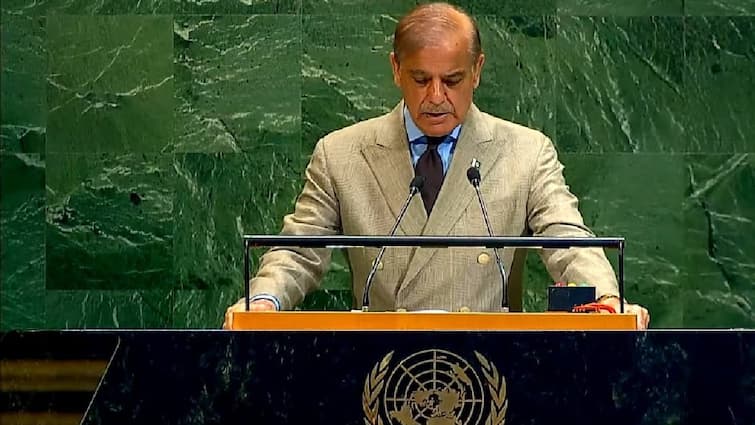In a statement that has raised eyebrows, Pakistan appeared to credit the United States for playing a key role in securing the ceasefire with India during Operation Sindoor. According to a readout of talks between Pakistani Prime Minister Shehbaz Sharif, Field Marshal Syed Asim Munir, and US President Donald Trump, Washington’s involvement was pivotal, at least from Islamabad’s perspective.
India, however, has consistently rejected claims that Trump had any hand in brokering the ceasefire. The Indian government has maintained that the initiative to halt hostilities came directly from Pakistan’s military leadership, not through third-party mediation.
Sharif Hails Trump as ‘Man of Peace’
During a Friday meeting with Trump, Sharif described the US President as a “man of peace” and credited his “bold, courageous, and decisive actions” with preventing a potential “major catastrophe” in South Asia. Geo TV cited the Pakistani PMO, noting that Sharif expressed deep admiration for Trump and praised his efforts to resolve global conflicts.
Sharif also thanked Trump for the US-Pakistan tariff agreement and invited American companies to invest in Pakistan’s agriculture, IT, mining, and energy sectors. Counterterrorism cooperation was another key point, with Sharif appreciating Trump’s acknowledgment of Pakistan’s role in combating extremism.
#BREAKING At UNGA, Pakistan PM Shehbaz Sharif :
“Pakistan agreed to the ceasefire facilitated by President #Trump Had he not intervened, it would have been war. President Trump is a man of peace. We nominated him for the Nobel Peace Prize, the least we could do”
Referred to… pic.twitter.com/9AWW9905zu
— Daar News (@DaarNews) September 26, 2025
Despite Pakistan’s portrayal of US involvement, India has repeatedly denied any third-party mediation during the operation, underscoring that its military actions and subsequent ceasefire were directly managed between Indian and Pakistani military leadership.
Yet, Pakistan’s official statement seemed to tell a different story:
“Prime Minister Muhammad Shehbaz Sharif and Field Marshal Syed Asim Munir met with US President Donald J. Trump at the Oval Office today. The Prime Minister lauded President Trump’s bold, courageous, and decisive leadership for facilitating the Pakistan-India ceasefire and praised his initiative to involve key Muslim world leaders to end the conflict in Gaza and restore peace in the Middle East.”
The statement added that discussions also covered strengthening bilateral ties, encouraging US investment in Pakistan’s key sectors, enhancing security and intelligence cooperation, and extending a cordial invitation for Trump to visit Pakistan at his convenience.
From India’s standpoint, the story is different. The ceasefire initiative came from Pakistan’s top military officer, who reached out to his Indian counterpart after India’s precision strikes in response to the Pahalgam terror attack, which killed 26 tourists in April. By then, India had already hit several key terrorist and military targets in Pakistan-occupied Kashmir (PoK), including radar installations, anti-aircraft platforms, hangars, and even an AWACS aircraft on the ground.
-1 AWAACS
-2 command & control centres
-2 SAGE systems
-3 hangars
-5 fighter jets including F-16s
-6 radars
-11 runwaysPakistan’s report card of Op Sindoor finally released by Indian Air Force chief 🔥 pic.twitter.com/dbFKmAsNOG
— Amit Kumar Sindhi (@AMIT_GUJJU) August 9, 2025
External Affairs Minister S. Jaishankar recently confirmed in Parliament that there was no direct communication between Prime Minister Narendra Modi and Donald Trump between the Pahalgam attack on April 22 and the ceasefire announcement on June 17. He noted that the US Secretary of State informed India that Pakistan was ready to engage, which then prompted the Pakistani DGMO to reach out.
Operation Sindoor: A Shift in India’s Strategy
Unlike previous operations such as the 2016 Uri surgical strikes or the 2019 Balakot airstrikes, Operation Sindoor marked a significant evolution in India’s strategic approach. It was expansive, technologically sophisticated, and unprecedented in scope.
Following intelligence linking the Pahalgam attackers to Lashkar-e-Taiba (LeT), India carried out precision strikes on nine locations across Pakistan and PoK, Muzaffarabad, Kotli, Bahawalpur, Rawalakot, Chakswari, Bhimber, Neelum Valley, Jhelum, and Chakwal, delivering 24 missile strikes in a single day. This made it India’s most extensive single-day cross-border operation to date.
The offensive, launched on May 7, lasted four days and concluded on May 10 after Pakistan’s DGMO requested a ceasefire. Indian officials have emphasized that Operation Sindoor is ongoing, with the government committing to target terror infrastructure wherever it arises.



